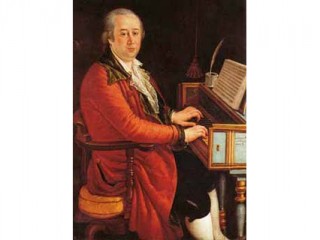
Domenico Cimarosa biography
Date of birth : 1749-12-17
Date of death : 1801-01-11
Birthplace : Aversa, Province of Caserta
Nationality : Italian
Category : Famous Figures
Last modified : 2011-03-05
Credited as : Opera composer, Il maestro di cappella , sonate for harpsichord or fortepiano
The works of the Italian opera composer Domenico Cimarosa typify the style of Italian opera buffa, or comic opera, in the late 18th century.
Domenico Cimarosa was born in Averso near Naples, the son of a very poor family. At the age of 12 he entered the Conservatory of S. Maria di Loreto; he studied composition, voice, and keyboard and sang major parts in conservatory performances.
Cimarosa's first opera, Le stravaganze del cante, was produced in Naples in 1772, the year he left the conservatory. From then until 1780 he moved between Rome and Naples, composing 15 operas for the two cities. By the 1780s he was the rival of Giovanni Paisiello, until then the acknowledged leader among opera composers in Italy. Italian companies performed Cimarosa's works in London, Paris, Dresden, and Vienna.
In 1787 Cimarosa went to St. Petersburg, Russia, as chamber composer to Catherine II, joining a long line of Italians who had held posts there beginning in the early 18th century. He composed two operas, Cleopatra and La vergine del sole, as well as cantatas and vocal and instrumental works during his stay. His constitution was not strong enough to stand St. Petersburg's weather, so he left in 1791 to become conductor to Leopold II in Vienna. It was here that he composed his masterpiece, Il matrimonio segreto, in 1792. This, his most popular work, is the only one to remain in the repertory. When Leopold II died that year, Cimarosa lost his position and returned to Naples, where he became conductor to the king and music teacher to the royal children in 1793. In 1799 he was imprisoned for publicly expressing his sympathy for Napoleon. After his release he left Naples for St. Petersburg; on the journey he died in Venice in 1801.
In addition to 61 operas, many with two versions, Cimarosa composed oratorios, cantatas, miscellaneous vocal works, and instrumental works, including 32 one-movement piano sonatas. His melodic gifts so impressed Goethe that he wrote two texts, Die Sprade and Die Bekehrte, to be sung to Cimarosa's melodies.
Cimarosa's operatic style is similar to that of many of his Italian contemporaries. The speed at which he composed is reflected in his tendency to use conventional procedures. However, he wrote dramatic ensembles very well, both within acts and as finales, to carry forward the dramatic action. Although these ensembles do not show the breadth and depth of a Mozart, they are well above the standard of contemporary practice.
Both Paul Henry Lang, Music in Western Civilization (1941), and Donald J. Grout, A Short History of Opera (1947; 2d ed. 1965), survey the 18th-century Italian tradition and discuss Cimarosa. See also George T. Ferris, The Great Italian and French Composers (1883).
Iovino, Roberto, Domenico Cimarosa: operista napoletano, Milano: Camunia, 1992.
















